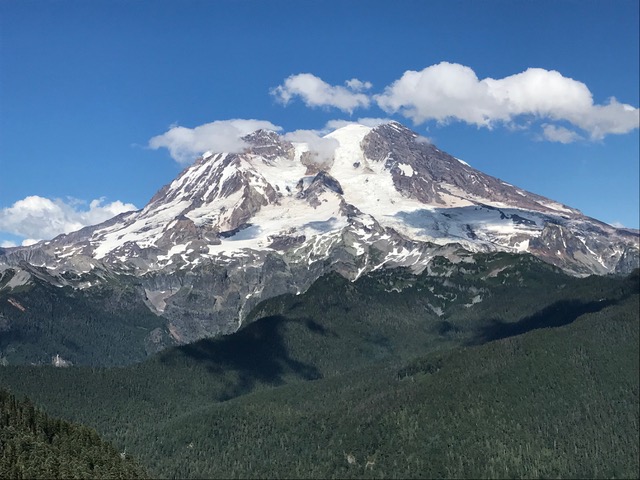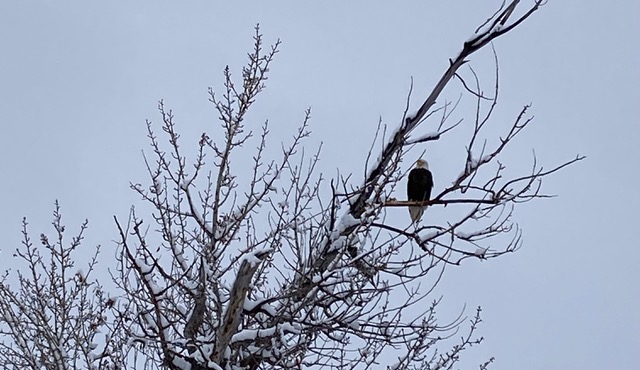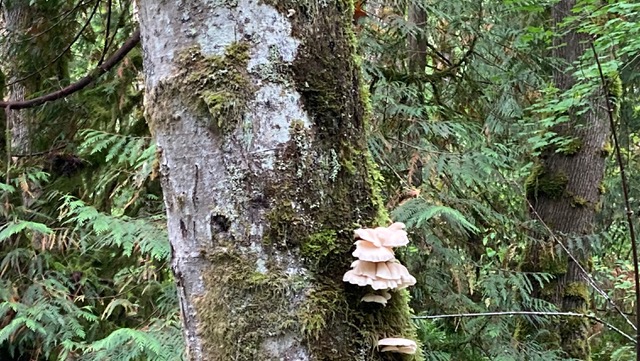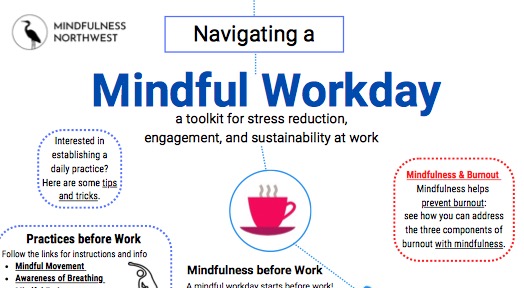
Photo by Beth Glosten
During challenges, I seek refuge in the wilderness. Nothing extravagant – usually a solo hike, sometimes an overnight trip. Physical exertion is a key component – I enjoy a bit of challenge to get me out of my head. At my age, it doesn’t take much: a couple of miles, a bit of elevation. I don’t set out to climb mountains – I set out to explore. When I’m out on a trail, alone, I let my mind expand: looking deep into the forest, hearing a river crashing down the slope, smelling cedar. I pause often, taking in the sights, sounds, and smells. This forest place cares little about my being in it. It carries on whether my feet walk this trail, or not. I love this feeling of being insignificant. It offers immediate perspective, a healthy humility.
I’ll never forget the first time I had a close-up view of Mount Rainier just outside of Seattle. It defined the word “awe”: a feeling of reverential respect mixed with fear or wonder. A powerful message from the mountain – don’t mess with me. DON’T MESS WITH ME!!! Mount Rainier didn’t care if I was there. And the next day my hiking plans were altered due to weather. I wasn’t about to mess with this mountain.

Photo by Beth Glosten
Our bodies in the wilderness are regular sources of awe, humility, and gratitude. The wilderness need not be terribly wild for our senses to be opened. In fact, urban settings can be very compelling places for a sensory feast: Walking in a city park, examining your own container garden or the local pea patch, or a short jaunt by a river all offer the opportunity to immerse in elements of the natural world, too. Even cracking a window or sitting on your deck or porch can invite everyday contact with the natural world.
At first glance, hiking, strolling in a park, or walking to your bus stop is an opportunity for movement. Physical exercise is a key element for maintaining good health, and such a motivation is terrific. If you are like me, however, if all I’m doing is getting out to exercise and get my heart rate up, I risk limiting my experience to the “beat, beat” thumping of my heart, my deep breathing, and my feet pounding the trail/road. These are prominent physical sensations, and for me, not always pleasant. My mind tells me that these sensations are good for me, but I can get stuck there, and not necessarily enjoy the time. Nonetheless, there is an opportunity to bring a mindful curiosity to the sensations of the body during exercise: a “being with” the body and “engaging with” the sensations, letting them be a guide. Should I slow down? Do I need a break? Can I find a helpful rhythm of breathing with my walking? Can I be more deliberate and careful? Can I offer support and encouragement to this body? Tune into the feet, the sweat, the breathing, the pounding heart and feel awe and gratitude for this body. Know that you are caring for your body and well-being by being outside.

Photo by Beth Glosten
And then, tune into being outside! Tune into your senses – sight, sound, smell. Nature offers a myriad of sensory stimuli and opportunities for richness.
Sight is the sense we tend to value the most and have the most fear of losing. Our eyes take in the colors and objects that surround us but with an editing system. If we registered everything we saw, we’d be paralyzed with input! We screen out what our brain thinks is insignificant, and we fill in missing details, unconsciously. Being mindful of the natural world and slowing down to take in the scenery in the forest, garden, or from the porch offers an opportunity to dig a little deeper into the details that are right in front of us.
For instance, the next time you’re outside, you could try engaging the mind with the varied textures of grasses, tree bark, flower petals, or leaves. Let the mind expand into the nuances of these plants growing right outside the door and be drawn to the uniqueness of the biological world. Paying attention to the sights around us keeps us in the present moment, this moment, seeing this flower, this rock. Notice the response – awe? Gratitude?
Or try opening your ears to the sounds in your environment . For me, sound is a unique portal of feeling connected to the world around me. As I open to sound, I feel a diminished definition of where the “me” stops and the “not me” starts — my boundaries of myself become vague. Notice the varied quality of sounds coming from the natural world, or the man-made world. What is your reaction to these sounds? Considering sound in nature might prompt marveling at the range of sounds around us that are heard by other animals, but not us. Bats use ultrasonic wave lengths (higher pitch than we can hear) for echolocation during flight; dogs can hear ultrasonic wave lengths. Snakes sense infrasonic wave lengths (lower pitch than we can hear), and whales, giraffes, dolphins, and elephants use infrasonic wave lengths for communication. As we walk along, who is hearing us? Kind of a humbling experience.

Photo by Beth Glosten
Our sense of smell, or olfaction, is the most direct connection of the outer world to our brain. It is the most primitive of the senses. Smell has the function of identifying pleasant or desirable things, such as food or flowers, and it also warns us of hazards. Smell also plays an important role in our perception of flavor. Humans navigate our world primarily by sight, but most organisms on this planet experience the world through their sense of smell. In nature, open your awareness to the smells around you – recently mown grass, a rotting log, the freshness of a recent rain. At the same time, know that you are being smelled. Grizzly bears have an acute sense of smell and can detect the scent of food from up to 18 miles away. Beware when hiking in grizzly country! Insects rely on smell to navigate their world via olfactory receptors located on their antennae and specialized parts of their mouth. Should you get lost in the wilderness, tracking dogs might find you using their advanced sense of smell.
Whether our body is moving and working out in nature or taking it all in from our apartment window, our sense of sight can draw us inward to the details of our experience. This, in turn, can foster awe and gratitude. Smell and sound can as well while also coaxing us out of our defined self toward the humble awareness of the vast natural world around us. As we intentionally connect with the world outside, we are just a tiny bit of all the life that thrives – seeing, smelling, hearing, being. Mindful awareness and curiosity help bring these experiences to life.
Do you like the notion of sensing and savoring the world around you? Check out this additional article for more ideas. Or try on these creative listening practices just for fun. Enjoy!

